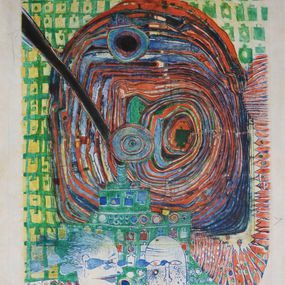Presentation
Friedrich Stowasser, better known as Friedensreich Hundertwasser Regentag Dunkelbunt, born December 15, 1928 in Vienna, Austria and died aboard the Queen Elizabeth 2 on February 19, 2000, is an Austrian artist, also an architect, of the twentieth century. Hundertwasser is the only child of unemployed engineer Ernst Stowasser and his wife Elsa. His father died thirteen days after his first birthday from appendicitis, and his mother was forced to take care of her son on her own. At the age of six, he entered the Montessori school in Vienna. There, art teachers attest to him "an unusual sense for form and color." Although of a Jewish mother, Hundertwasser was baptized in church in 1935. After the annexation of Austria in 1938, he participated in the Hitler Youth groups. In order not to attract the attention of private school students, Elsa Stowasser sends her son to public school in Vienna. After graduating from Horn Secondary School in 1948, he attended the 1948/49 winter session, for three months, of the Academy of Fine Arts in Vienna. There he began to sign his works with the pseudonym Hundertwasser. He abandoned his studies soon after. Hundertwasser travels in April 1949 for the first time to Italy where he meets the French artist René Brô. In 1950, they went to Paris together. Then Hundertwasser made other trips to Morocco (first semester 1951), Tunisia, Sicily and the “Bürgeralm” (refuge) in Aflenz in Styria. Hundertwasser made his first exhibitions in 1952 and 1953 in his hometown of Vienna, then in 1955 in Milan, in 1954 and 1956 in Paris. In 1957, Hundertwasser acquired a farm in Normandy, in Saint-Jean-de-la-Forêt. In 1958, he married Herta Leitner in Gibraltar. They divorce two years later. In 1960, Hundertwasser traveled to Japan, where he received the Mainichi Prize in 1961 at the 6th Tokyo International Art Exhibition. In 1962, he married the Japanese Yuko Ikewada, but the marriage broke down in 1966. In Japan, he began to use the name Friedensreich (Kingdom of Peace). [Ref. necessary] After his farm in Normandy, Hundertwasser bought the “Hahnsäge” in 1964, a sawmill that had been decommissioned in a forest area and sparsely populated in Lower Austria. Far from all hustle and bustle and in the midst of nature, he is setting up new accommodation. In 1964, his works were presented at Documenta III in Kassel, in the painting department. From 1969 to 1971 he worked with director Peter Schamoni for the film Hundertwasser Regentag. This is, after the documentary film Hundertwasser by Ferry Radax (1966), the second film on the artist's life. In the film, it is about an old freighter, with which Hundertwasser sailed from Sicily to Venice in 1968 and which after renovations became the "Regentag" (rainy day). In 1972, Hundertwasser founded the "Grüner Janura AG" (public limited company) in Switzerland, which was renamed "Namida AG" in 2008. Through this limited company Hundertwasser manages its literary and artistic copyright. In the 1970s, Hundertwasser acquired several properties in the Bay of Islands in New Zealand, which included with a total area of 372 ha, the entire "Kaurinui" valley. There, he realized his dream of living and working in nature and among others in the "bottle house" he had designed. He installed solar collectors, a water wheel and a plant water treatment station there, which allowed him to live in self-sufficiency. He also experiments with the technique of planted roofs. In 1979, Hundertwasser acquired, through his Swiss company, the "Giardino Eden" in Venice, a large garden of 15,000 m2 with a palazzo. Hundertwasser designed one of the artist posters published for the 1972 Summer Olympics in Munich. In 1975, he began to design postage stamps. In 1982, he redesigned the facade of the "Rosenthal" factory. A year later, the first stone of the Hundertwasser house in Vienna was laid and on February 17, 1986 the tenants received the key. In the following years, Hundertwasser worked for numerous architectural projects in Germany, Austria, Switzerland but also in California, Japan and New Zealand. In 1984, he actively participated in the occupation of Hainburger Au, a Danube nature reserve, to prevent the construction of a power station. He even tore his Austrian State Grand Prix in front of the camera. In 1993, he was called upon to conceive the artistic design of the new edition of the Latin-German school dictionary "Der kleine Stowasser" by Joseph Maria Stowasser, "as a gift to the youth" (editor's formulation). This jubilee edition of the dictionary was distributed in German-speaking countries and published in 1994 in exactly one hundred different versions (by color variations). The dictionary is still like that today. In 1995, the "Hundertwasser Bibel" was published. This 1,688-page book is illustrated with thirty collages, created especially for this edition, and some fifty works of art. The covers are handmade and each one is unique. Friedensreich Hundertwasser died on February 19, 2000 on his return from Europe to New Zealand aboard the Queen Elizabeth 2 due to heart failure. According to his last wish, he is buried on his property in New Zealand under a tulip tree, without a coffin, naked and wrapped in a "Koruflagge" (flag he designed for New Zealand) According to his manager, Joram Harel, Hundertwasser was penniless and his estate was in over-indebtedness due to his expensive lifestyle.
Read more
All artworks of Friedrich Hundertwasser

No artworks by Friedrich Hundertwasser are currently available. To receive the latest information about their new pieces for sale, you can follow the artist or contact our Customer Service directly through the provided link.
Discover our selections of works by artists
Need help finding your favorite? Consult our selection pages made for you.
Need to know more?
When was Friedrich Hundertwasser born?
The year of birth of the artist is: 1928
